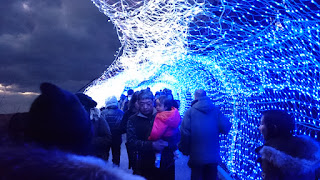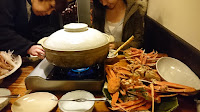After living in Tottori for almost 5 months, I finally did the tourist thing in my own city on the weekend of 12/19. Two ALTs from the Kansai area, Mandy and Valerie, drove up to see the sights in my neck of the woods.
 We started our day with inshu-washi, traditional Japanese paper-making in the nearby town of Aoya. The process involves stripping trees of bark and turning the fibers into a mush, which is then dried on a screen. Dyes and additional paper can be applied to the paper during drying process, creating the opportunity to turn the sheets into works of art.
We started our day with inshu-washi, traditional Japanese paper-making in the nearby town of Aoya. The process involves stripping trees of bark and turning the fibers into a mush, which is then dried on a screen. Dyes and additional paper can be applied to the paper during drying process, creating the opportunity to turn the sheets into works of art. After our designs are meticulously created, they then use a vacuum to suck out the water, and the a heated wall to dry the paper, so a process centuries ago took days, today could be done in minutes. At the end we all had created paper lamps we got to take home. Before we left we got the chance to peruse the main display area, which had some impressive papercraft such as an origami zodiac display, paper bouquets, and even paper models of paper-making!
After our designs are meticulously created, they then use a vacuum to suck out the water, and the a heated wall to dry the paper, so a process centuries ago took days, today could be done in minutes. At the end we all had created paper lamps we got to take home. Before we left we got the chance to peruse the main display area, which had some impressive papercraft such as an origami zodiac display, paper bouquets, and even paper models of paper-making!
 Back in Tottori we stopped briefly at the fish market for some seafood donburi (rice bowl), and then some gelato dessert. The hall was filled with a wide variety of freshly caught fish on display, and matched the variety of fresh fish in my lunch, which was artistic, filling, and delicious. Oddly enough, while we think of Japan as a land of seafood, only some select coastal cities like Tottori actually feature fresh seafood.
Back in Tottori we stopped briefly at the fish market for some seafood donburi (rice bowl), and then some gelato dessert. The hall was filled with a wide variety of freshly caught fish on display, and matched the variety of fresh fish in my lunch, which was artistic, filling, and delicious. Oddly enough, while we think of Japan as a land of seafood, only some select coastal cities like Tottori actually feature fresh seafood.
 Next we headed to the main attraction, the Tottori Sand Museum. This large building next to Tottori's famous sand dune features massive sand sculptures from artists all over the world. This year's theme was Germany, and featured displays of fairy tales, renditions of German artwork, landmarks, and famous moments in German history all meticulously carved in sand. They had dramatic, real life moments such as the fall of the Berlin wall recreated in sand. They also constructed fantastic fantasy creations with scenes from the Brother's Grimm (and the brothers themselves). The final display on the fall wall perfectly encompassed the exhibit. It was a grand structure of scenery, blending historically accurate meetings of aristocracy with nods to Cinderella within the work. The artists seemed to make their best effort in encompassing all of Germany's accomplishments; literary, scientific, and historical. While all of the works are masterpieces, my favorite had to be the Faust sculpture, which presented most of the story elements in a single dramatic scene.
Next we headed to the main attraction, the Tottori Sand Museum. This large building next to Tottori's famous sand dune features massive sand sculptures from artists all over the world. This year's theme was Germany, and featured displays of fairy tales, renditions of German artwork, landmarks, and famous moments in German history all meticulously carved in sand. They had dramatic, real life moments such as the fall of the Berlin wall recreated in sand. They also constructed fantastic fantasy creations with scenes from the Brother's Grimm (and the brothers themselves). The final display on the fall wall perfectly encompassed the exhibit. It was a grand structure of scenery, blending historically accurate meetings of aristocracy with nods to Cinderella within the work. The artists seemed to make their best effort in encompassing all of Germany's accomplishments; literary, scientific, and historical. While all of the works are masterpieces, my favorite had to be the Faust sculpture, which presented most of the story elements in a single dramatic scene.Outside of the museum, the artists had set up another notable work. Trending with the times, they had built a star wars display in celebration of the new movie release.


 As we finished our tour of the museum, the exterior lit up in brilliant blue. During the holiday season the museum features two large illuminations on it's grounds. The Mechanical Department students at my school have contributed works to these displays in the past, so I bet some of these light sculptures were theirs. The first, right next to the museum, had an ocean theme. There were sculptures of waves, mermaids, and even a boat. The hillside was blanketed in waves of light, and the walkway through was structured to appear as a barrel of a wave. At the top of the hill was large illuminated platform filled with marbles, accompanied with tranquil music, created an otherworldly scene. There was also a tree sculpture with a bell you could ring for good luck!
As we finished our tour of the museum, the exterior lit up in brilliant blue. During the holiday season the museum features two large illuminations on it's grounds. The Mechanical Department students at my school have contributed works to these displays in the past, so I bet some of these light sculptures were theirs. The first, right next to the museum, had an ocean theme. There were sculptures of waves, mermaids, and even a boat. The hillside was blanketed in waves of light, and the walkway through was structured to appear as a barrel of a wave. At the top of the hill was large illuminated platform filled with marbles, accompanied with tranquil music, created an otherworldly scene. There was also a tree sculpture with a bell you could ring for good luck!The next display, in the parking lot, was a grand rendition of the famous white rabbit of Inaba story, accompanied with it's own light show and musical performance. This story is the famous folklore of our area, and you can read about it here: https://en.wikipedia.org/wiki/Hare_of_Inaba. Unfortunately my battery was running low, so I didn't get the chance to film it for you.

 Afterwards we went to one of my favorite restaurants in Tottori, Sarashina. A small, family owned, traditional Japanese restaurant right behind my school, I go when I can to eat fresh local food. Tonight was no exception, since we had a reservation to eat renowned Tottori crab in a hotpot, in Japanese, kaninabe. The sheer amount of crab they prepared for us was staggering, two plates full of grilled crab, in addition to the large hotpot plate. In true Japanese fashion, they had considerately cut every single crab leg and body for easy eating. We began what ended up being a 5 hour feast. 4 hours in, when we had finally finished the nabe (hotpot) crab, they poured rice and eggs into the hotpot, turning the broth into a porridge. Throughout the meal we had a lot of fun chatting with the chef and his mother. My friends are a fair amount more proficient in Japanese, so I was glad we had the opportunity to entertain them as they entertained us.
Afterwards we went to one of my favorite restaurants in Tottori, Sarashina. A small, family owned, traditional Japanese restaurant right behind my school, I go when I can to eat fresh local food. Tonight was no exception, since we had a reservation to eat renowned Tottori crab in a hotpot, in Japanese, kaninabe. The sheer amount of crab they prepared for us was staggering, two plates full of grilled crab, in addition to the large hotpot plate. In true Japanese fashion, they had considerately cut every single crab leg and body for easy eating. We began what ended up being a 5 hour feast. 4 hours in, when we had finally finished the nabe (hotpot) crab, they poured rice and eggs into the hotpot, turning the broth into a porridge. Throughout the meal we had a lot of fun chatting with the chef and his mother. My friends are a fair amount more proficient in Japanese, so I was glad we had the opportunity to entertain them as they entertained us. The next day we headed into town to Hotel Monarque to use their onsen. Tottori is somewhat unusual in that it has a natural spring right in the center of town. Many springs throughout the country are relatively remote, so resort towns are built around them. Thankfully I do not have to travel far to relax in these waters. The Monarque is the one high end western style hotel in our city, and while it is expensive to stay the night, access to the bath is reasonable. The Monarque also has the perk of a sauna in the bath area. Feeling fresh after this relaxing start to our day, we set back off into the sand!
The next day we headed into town to Hotel Monarque to use their onsen. Tottori is somewhat unusual in that it has a natural spring right in the center of town. Many springs throughout the country are relatively remote, so resort towns are built around them. Thankfully I do not have to travel far to relax in these waters. The Monarque is the one high end western style hotel in our city, and while it is expensive to stay the night, access to the bath is reasonable. The Monarque also has the perk of a sauna in the bath area. Feeling fresh after this relaxing start to our day, we set back off into the sand!We drove back out to the sand dunes, this time to wander the dunes themselves. Mandy and Valerie opted to ride the camels at the dunes, which was amusing and fun! We learned the camels are from Mongolia (I didn't know Mongolia had camels), so they handle cold weather very well and actually struggle in the heat during the summers. We then wandered on top of the main ridge and took in the views before ending our evening at a local Indian restaurant.
I had a great time exploring my own area of Japan with some fantastic people, I should have done so months ago!







No comments:
Post a Comment